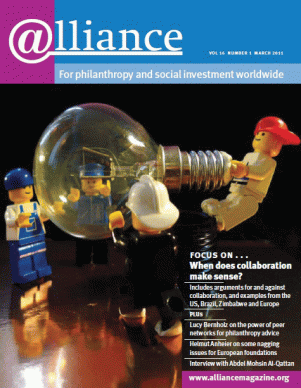This book is for you if you are even remotely interested in seeing a more equitable world. If you ever wondered why there is still such widespread suffering in the world, despite trillions of development dollars spent annually for several decades, Cheng and Mohamed have some answers for you. It doesn’t matter if you work for a social purpose organization, business enterprise, government or media, or if you are just a concerned citizen, once you’ve read this book you will appreciate the nuances of what could change our world for the better. The book couldn’t have been more timely, as the UNDP has recently developed an Acceleration Framework to achieve the Millennium Development Goals by 2015.
 In a uniquely collaborative manner, Cheng and Mohamed have assembled a group of cutting-edge thinkers and practitioners in the social sector to write the different chapters of the book. The rich and diverse perspectives brought in by Jon Huggett on social enterprises, Sara Olsen on social intermediaries, Stephen Young on moral capitalism, Robert Chew on technology for society, and Kumi Naidoo on civil society, among several others, provide a holistic overview of the large and thriving community that would be equivalent in size to the world’s fifth largest country.
In a uniquely collaborative manner, Cheng and Mohamed have assembled a group of cutting-edge thinkers and practitioners in the social sector to write the different chapters of the book. The rich and diverse perspectives brought in by Jon Huggett on social enterprises, Sara Olsen on social intermediaries, Stephen Young on moral capitalism, Robert Chew on technology for society, and Kumi Naidoo on civil society, among several others, provide a holistic overview of the large and thriving community that would be equivalent in size to the world’s fifth largest country.
More importantly, Cheng’s exceptionally perceptive opening chapter stitches these diverse pieces together through an ecosystem framework. In his own words:
‘At the core of a social ecosystem are the social purpose entities that seek to positively impact their beneficiaries, and the capacity builders that facilitate the mission of these social purpose entities. Around them are the community (individuals and corporations), media, and government (including one of its distinctive roles as the regulator) who collectively provide the resources, support, and scrutiny to ensure that the core players function as intended.’
Once you read this opening chapter and visualize the ecosystem framework, all the disparate pieces in the table of contents appear to be part of the same puzzle!
All the chapters are insightful in themselves. Sample these. Talking about the culture of charities in one of the chapters, Gerard Ee opines: ‘The same compassion that drove the formation of Charities to help the poor and needy, can result in poor governance, low performance, poorly paid workers, and a narrow focus on the needs of the poor that leads to suboptimal outcomes.’ In another chapter, which lays down an agenda for the future, John Elkington recommends: ‘The Phoenix Economy can be more rapidly achieved with concerted actions around an Agenda that comprises three building blocks. A manifesto that drives necessary change in the public sector, a prospectus that shapes investor and business decision making and strategy, and a Syllabus that informs future business education.’
The role of, and need for, intermediaries such as grantmakers and other service providers (that seek to build the capacity of the social sector) may not always be well appreciated. The fact is that all ecosystems need intermediaries to facilitate the core activities and oil the wheels of the marketplace. The editors did full justice to this by including three chapters on the ‘capacity builders’.
On a different note, social media, naturally identified as a key trend in the book, could have been dealt with at greater length, given its game-changing potential. In the chapter on technology, Robert Chew does say ‘the key value of new media is that it is simple, instantaneous, and viral’. Elsewhere in the book, Chris Cusano says ‘a vibrant citizen sector will ensure that society distils its highest empathetic ethics into the real hard stuff of social change’. My argument is that social media have the power to improve the vibrancy of the citizen sector and therefore merit much more space.
After reading this valuable one-stop-resource on the social sector, what else could one ask from the editors? Maybe an action-oriented epilogue! My personal experience is that ecosystems work when there is an orchestrator. Without a powerful orchestrator, participants in such a complex ecosystem as the social sector will find it difficult to act in concert. The epilogue could have identified potential orchestrators from within the ecosystem, and described what it would take for them to play such a role.
All in all, when you are done with this book, I am sure you will have a ringside view of the fascinating social ecosystem: what it is, what it could be, and where it could be going. You may even discover some innovative ways in which you can shape that journey …
Shiv Sivakumar is chief executive – agribusinesses of India’s diversified conglomerate, ITC Ltd. He is the architect of ITC eChoupal, an innovative business model that raises the incomes of small farmers while delivering sustainable shareholder value. Email sivakumar.s@itc.in
The World that Changes the World: How philanthropy, innovation, and entrepreneurship are transforming the social ecosystem
Willie Cheng and Sharifah Mohamed (eds) Jossey Bass $29.95/€24/£19.99
ISBN 9780470827154
To order
http://www.worldthatchangestheworld.com




Comments (0)